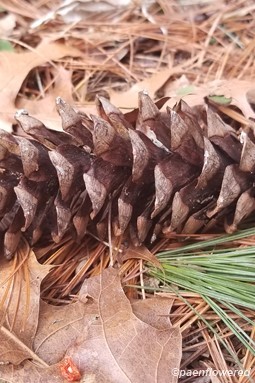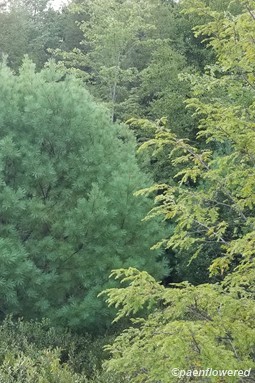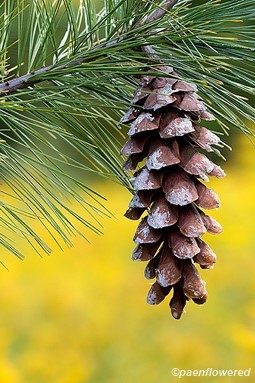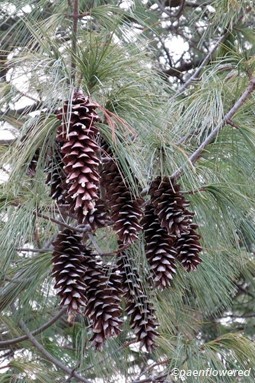Pinus strobus
A common native pine with 5-bundled needles
Pinus strobus eastern white pine
This native species of pine is easily recognized because its long thin needles are in bundles of five, the only pine in this region with that arrangement. These needles tend to be bluish-green in color and two to five inches long. This species is found in southeastern Canada, northeastern United States, the Great Lakes region and south to Georgia in the mountains. It may grow from 70 to 110 feet high, though a dwarf variety exists in the colder and windier part of its range.
The branches are horizontal and arranged in whorls around the trunk. There are fewer limbs than on other pines and they tend to be heavier. The bark on small trees is smooth and greenish gray. As the tree ages the bark becomes dark and deeply ridged. The young pollen cones are yellow and the seed cones are initially purple. These slender seed cones can be 4-8 inches long and have no spines. They produce winged seeds.
The eastern white pine is an attractive ornamental and had been a valuable tree for lumber. The wood is light, soft and has straight grain and not as resinous as other pines. The tree was so extensively harvested that few of the largest trees remain. Reforestation is underway in many areas. The tree is vulnerable to the white pine blister rust fungus. This can be controlled by removal of currants and gooseberries, an intermediate host for the fungus. The white pine weevil can also damage the tree.
The white pine is frequently used as a Christmas tree because of the long attractive needles and because it retains these needles well after being cut.
Habitat & Range
Common in forests throughout.
Present throughout the state.
Range: Southeastern Canada, northeastern United States, the Great Lakes region and south to Georgia in the mountains.
| EMP: | FACU |
|---|---|
| NCNE: | FACU |
Phenology
Produces pollen in April.
Characteristics
Tree trunk single and tall, with whorls of horizontal branches evenly spaced along trunk, branches concentrate near top when mature; crown irregular
Needles 5 per cluster; soft, flexible, 3 sided; bluish green; 2-5 inches long
Twigs slender, flexible; buds egg-shaped & gray-brown
Bark smooth & greenish gray when young, proceeds to turn brown and break into large scales as it matures
Seed Cones green when young, turns brown at maturity; drooping, curved, with pointy white tip on each cone scale; coated with resin; 4-8 inches long
Height 70-110 feet
Fall Color evergreen
Age 200-250 yrs
Identification Tips
5 needles per cluster
Plant Codes
S-rank: S5 (Secure)
G-rank: G5 (Secure)
Ecology
The seeds and soft needles of white pine are a source of food for various birds, mice, squirrels and chipmunks. Porcupines eat the inner bark in winter and deer browse the twigs.




















Comments
Have you spotted this plant in your area? We'd love to hear about your experience! Share your comments or questions about the plant below. Comments are moderated before posting.